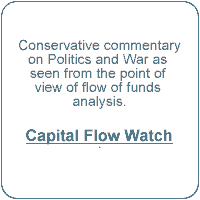Basic Capital Flow Analysis: Presumed Dominance of Issuers of Securities
 Presumed Dominance of Issuers of Securities
Presumed Dominance of Issuers of Securities
Presumed Dominance
Capital Flow Analysis is a technique in which Federal Reserve flow of funds accounts are used to explain supply and demand in U.S. securities markets.
We presume that issuers dominate investors.
The method involves selectively focusing on the various market sectors, starting with the flow table for the class of security being studied and then moving to the sector tables for motivated buyers or sellers, and finally, by analyzing the flow sheets of each sector, finding the explanation for the observed behavior.
There are many players in the market, but some are more important than others.
Generally, we presume that issuers dominate investors.
The Starting Point
The Dominance Presumption provides the starting point for our analysis.
This rule states that issuers usually have a greater effect on prices than investors have.
The Wall Street adage that ‘stocks are sold, not bought’ signals the dominance of issuers and the intermediaries who work for them.
An old Wall Street adage suggests the dominance of issuers.
The most important issuers are those that actually create stocks, bonds, and other securities to finance industrial or commercial operations.
Institutional intermediaries, such as mutual and pension funds, do not dominate the market in the same way as do the issuers of portfolio securities.
In the case of equities, the Dominance Presumption places corporations as the 'usual suspects' when trying to explain stock price movements.
The Dominance Presumption is just that — a presumption. Sometimes corporations are not the primary force behind stock price trends:
- For example, program trading by institutions in the secondary market caused the Crash of October 1987.
- Naive investors rioted in newly opened stock markets in Shanghai and Jakarta in the 1990s in their eagerness to buy shares.
- Excessive margin trading by speculators touched off the Crash of 1929.
The Dominance Presumption
The Dominance Presumption may be stated as follows:
Issuers Dominate Markets
Motivation drives investment markets, but the motivation of corporate or government issuers is usually stronger than the motivation of investors.
Corporations and governments set the price at which they sell or buy securities and investors respond to these offers. Corporations use investment banks and other intermediaries to persuade investors to accept their offers and to adjust their holdings.
Why Issuers Have the Advantage
Without issuers, there are no securities. Issuers hire investment banks to sell their securities or to carry out buyback programs.
Issuers have the opportunity to engage in discussions with underwriters about the terms and conditions of an offering.
Investors react to marketing efforts of brokers. Here are some advantages that issuers hold:
Inside Information:
Issuers have information that is not available to investors.
Full disclosure rarely occurs.
Although securities regulators require prompt disclosure of material information, 'full disclosure' is difficult to achieve and rarely occurs.
Instead, there is a tacit compromise about what comprises full disclosure and issuers reveal only partial information.
Persuasion:
Issuers can use professional persuaders to prod investors to act.
Issuers hire brokers to convince investors to buy.
When issuers want to sell securities, they hire brokers to convince investors to buy.
Except in secondary offerings, investors rarely have such an advantage.
Investors must accept the market price.
Product Control:
Issuers can tailor securities to attract investors.
Investors can only sell securities with terms and conditions set by the issuers.
Control of Intermediaries:
Intermediaries that stand between investors and issuers usually favor issuers because commissions earned from a single investor are far less than fees earned from an underwriting client.
Before the Crash of 2000, brokers rarely made selling recommendations, because to do so might offend corporate clients.
Guided Disclosure:
Companies pay the accountants, auditors, and lawyers that prepare information for investors.
Within accepted guidelines, issuers have wide latitude and means to shade information to their benefit.
Issuers Also Act Irrationally
It is necessary to focus on issuers because they have great power over the market and do not necessarily exert this power in ways that economists might consider rational.
Issuers cannot be presumed to act rationally.
Rational behavior for issuers would be to sell securities when price earnings ratios rise or interest rates fall and refrain from doing so when cost of capital is high.
However, for extended periods, issuers have done just the opposite — buying and retiring their own stock when the cost of capital has been low (i.e., when price earnings ratios are high).
Over the last fifty years, American corporations displayed this contradictory behavior about half of the time.
Foreign Issuers Are Also Important
Domestic corporations are not the only issuers in the American market.
New offerings of stock by foreign companies contributed to the market crash of 2000.
Foreign companies have different tax incentives, ownership patterns, and managerial behavior than U.S. corporations.
No Presumption As To Behavior
When beginning our analysis of Federal Reserve flow of funds accounts, we may presume that corporations dominate the market.
However, we can not presume what their behavior might be.
For this, we need to review flow of funds accounts and other information.
Before proceeding, check your progress:
Self-Test
The Dominance Presumption states that, usually:
|
|
The Wall Street adage that reminds us of the Dominance Presumption is:
|
|
From the issuer's point of view, their cost of capital usually falls when:
|
 learning module : continued >
learning module : continued >
Suggested Reading:
External Links
| 'Stocks are sold, not bought' : Interview with John Gutfriend, The Streetwise Director, Summer 2000. [Return] |
| Crash of October 1987 : Article by Bob Woodward, Washington Post, November 13, 2020. [Return] |
